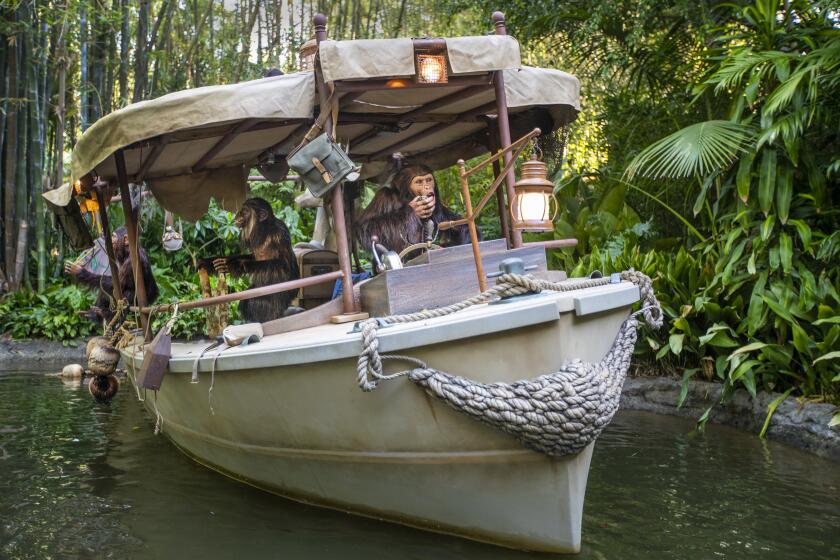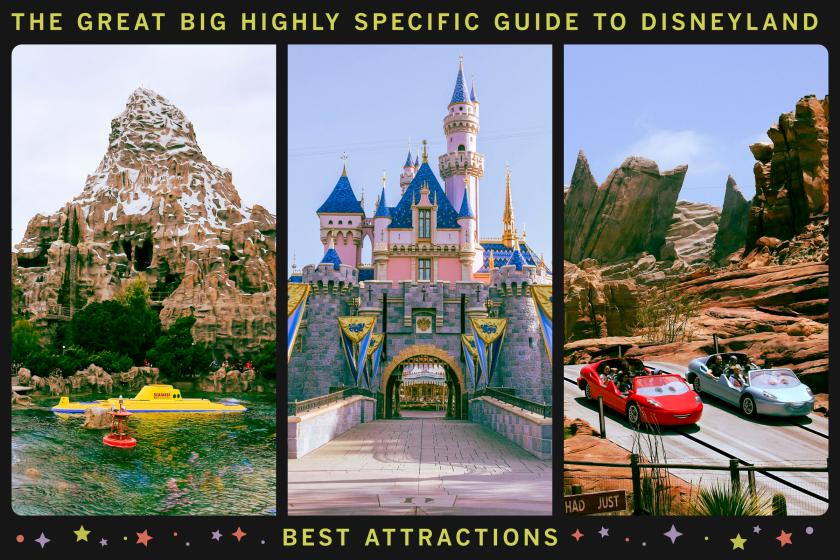Meet one of Disneyland’s leaders in bringing diverse, adventurous entertainment to the parks
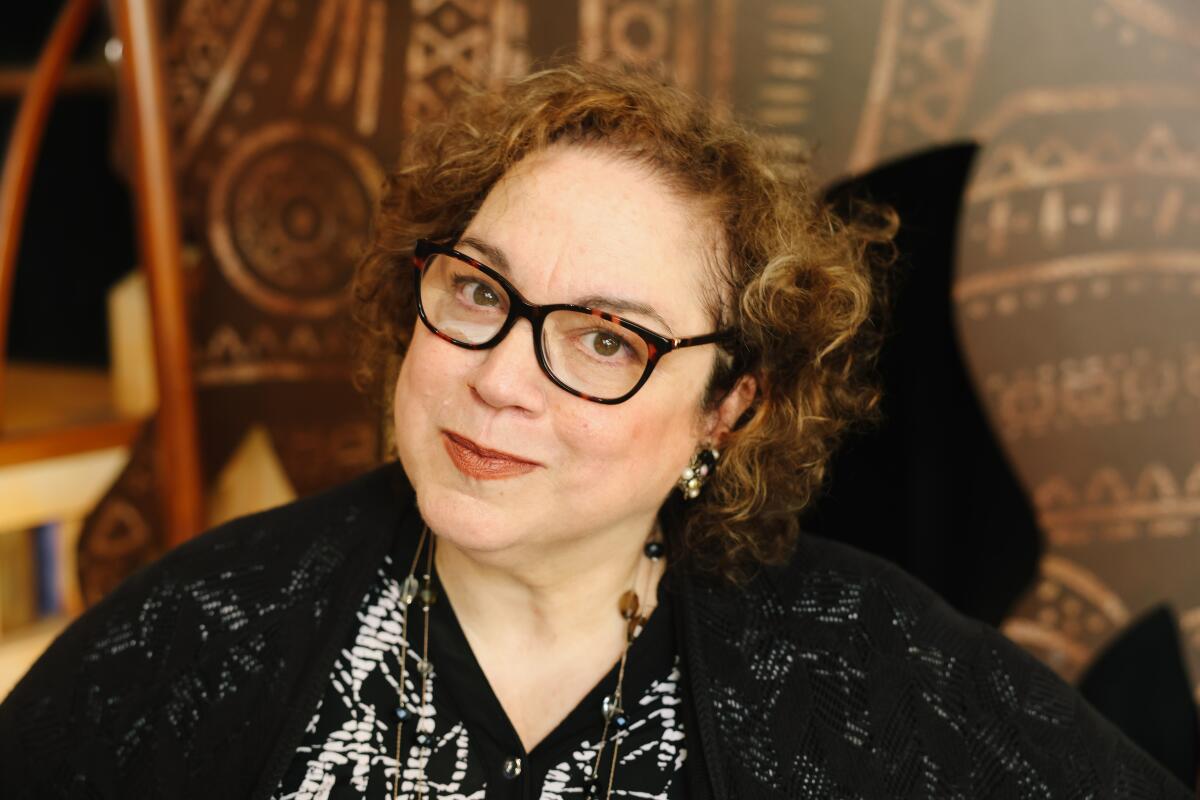
- Share via
For about three decades Susana Tubert worked in New York theater, dreaming of Broadway while building an extensive resume that contains numerous writing, directing and educational credits. Along the way she collaborated with luminaries of the field, including director Harold Prince, and discovered those Broadway ambitions weren’t necessarily the pinnacle she desired.
A fierce advocate for fresh and diverse voices, in 2007 she led the TeatroStageFest, which ran through 2013 and brought to New York new works from Latin artists here and abroad. Tubert’s career has touched ballet, musical theater, puppetry and a short film. But it’s a different type of theater that is getting Tubert excited on a recent weekday afternoon: fireworks.
Since 2013, Tubert has worked for the Disneyland Resort, today leading or collaborating on much of the live entertainment found in its two theme parks. That’s given her the opportunity to work on unconventional stages, the kind that a young New York thespian may have once rolled her eyes at, like the night sky above Sleeping Beauty Castle.
But when Tubert discusses fireworks, she speaks of them like characters, for instance in the way they can be launched to create an illuminated illusion of a marigold bridge to reference Pixar film “Coco.” It was this moment in the now-retired “Together Forever: A Pixar Nighttime Spectacular” that, when combined with projections, turned the old-timey American feel of Main Street, U.S.A., into a pure Mexican American celebration.
“Our fireworks designer was the one who got it first,” Tubert says. “He said, ‘I think I know what you’re after. You want to do theater in the sky?’ ‘Yeah, actually, I do. Can we do that?’”
Tubert and her team did it by giving the firework show “movements”: “Unlikely characters, chance encounters, they meet, they fall in like, they go on adventures together and they overcome obstacles and forge everlasting bonds. It’s a structure. It’s an internal dramaturgy. The audience may not know that consciously, but they feel the rhythms of the arc.”
Over the years, Tubert has worked on a wide variety of projects at the Disneyland Resort. As the architect of Disney California Adventure’s Festival of Holidays, she’s overseen the park‘s extension of a hand to global cultures, and with mini street parade Disney ¡Viva Navidad! she uses the characters from Disney’s mid-1940s goodwill film “The Three Caballeros” to showcase folklórico dancers and mariachis as well as 12-foot-tall mojiganga puppets. With “Tale of the Lion King,” Tubert led a production featuring Disneyland’s first all-Black ensemble cast, one that centers traditional dance and aims to capture the feel of ancestral storytelling.
Tubert’s work has gradually helped shape the modern feel of the parks.
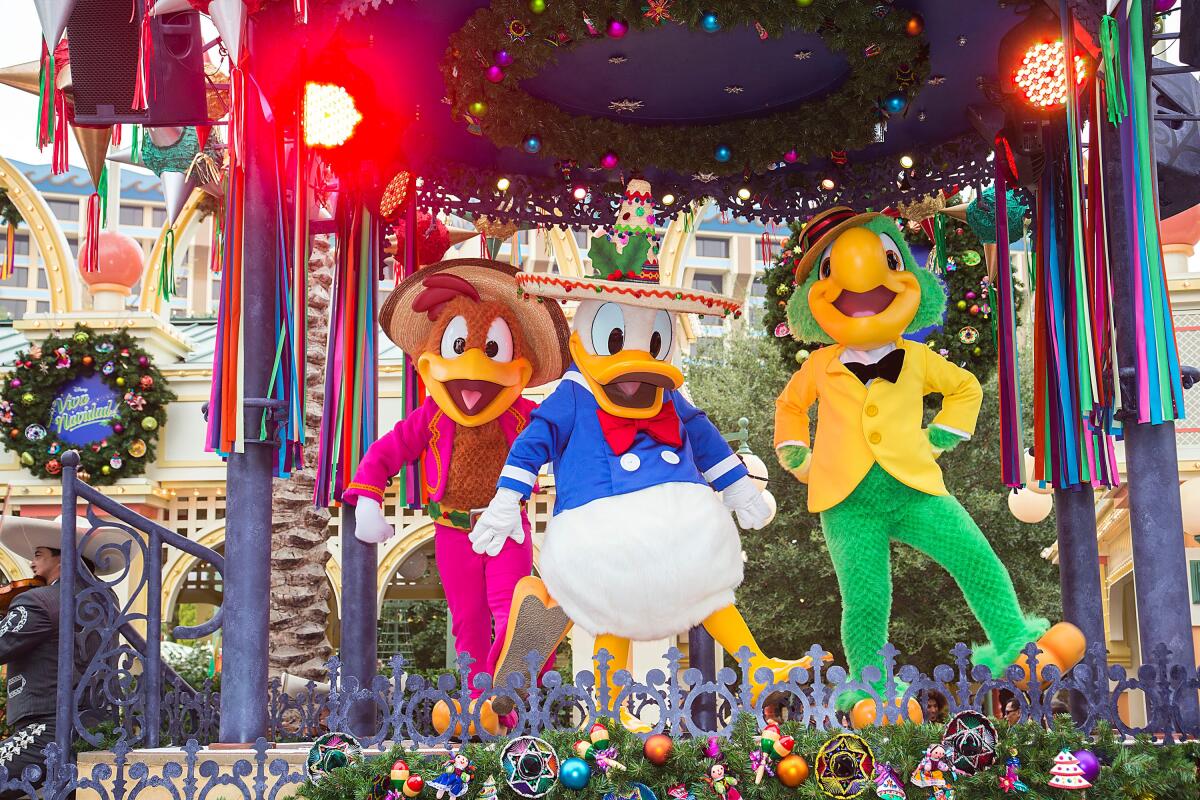
Her team added a new float to the recent revival of the Main Street Electrical Parade, one that nodded toward Disney’s modern films and gave the classic processional an infusion of diversity. In 2021, she was part of the creative team that reworked the Jungle Cruise, at long last doing away with negative tribal depictions to create an attraction that steers clear of racial stereotypes. And she’s helped the Disney parks more authentically recognize the spirit of cultural traditions such as Lunar New Year. It was Tubert, for instance, who during the parks’ Día de Los Muertos celebrations created a “memory wall,” asking all Disneyland guests to write a letter to a departed loved one.
“I managed to get people to think about their loved ones who passed away at the Happiest Place on Earth,” Tubert says with a laugh.
At the time of the interview, she was readying experiences to coincide with the launch of Disney’s live-action “The Little Mermaid,” a character encounter she describes as “whimsical,” and one that will continue Tubert’s mission for Disneyland to better reflect the full breadth of its clientele. Recently, she was recognized by the Themed Entertainment Assn., receiving the organization’s yearly Catalyst Award for her lifetime of work in the theater and entertainment.
As theme parks double down on brands associated with film and television, Tubert continues to view them as places of communal, living theater, using recognizable properties not as reference but as jumping-off points. Tubert’s team looks for ways to focus its events on the cultures Disney films represent rather than simply the films themselves.
“For me, the revelation was not so much that we could do that,” Tubert says. “I had been doing representation. But anyone can put folklórico dancers and mariachi musicians in Southern California in a mall. But no one else can do it from the point of view of the Three Caballeros hosting a street party. Donald Duck is Everyman, every duck. He’s a culture seeker. We anchor culture celebrations through the point of view of these characters. The characters represent the beloved bridge that drops and invites you to cross into someone else’s world.”
Tubert was far from a theme park regular when she made the transition from New York to Anaheim, a decision fueled partly by the financial realities of running the TeatroStageFest and its 2013 closure. But she started with what she knew, and quickly learned that theme parks are theater on a broad scale. One of Tubert’s initial projects at the parks was California Adventure’s Disney ¡Viva Navidad!, which she launched in her first year in 2013 and has now become a holiday staple.
It was an instant crowd-pleaser, and illustrated to Tubert the ways in which theme parks have little to no separation between cast and guest. When it launched, Tubert was still mourning the closure of TeatroStageFest and adjusting to trading Manhattan for Main Street, U.S.A.
“I lived in a one-bedroom apartment in Chelsea for 33 years — my home,” Tubert says. “I had to quickly make decisions and go. And at the very last performance of ¡Viva Navidad!, this little girl — this little Mexican girl — she rushed up to one of our folklórico dancers, hugged her at the knees, looked up and said, ‘You’re my favorite princess.’ I started crying. In that moment, I may have closed the organization and the festival, but that mission lives on inside of me. And I can bring that mission here. It’s not over.”
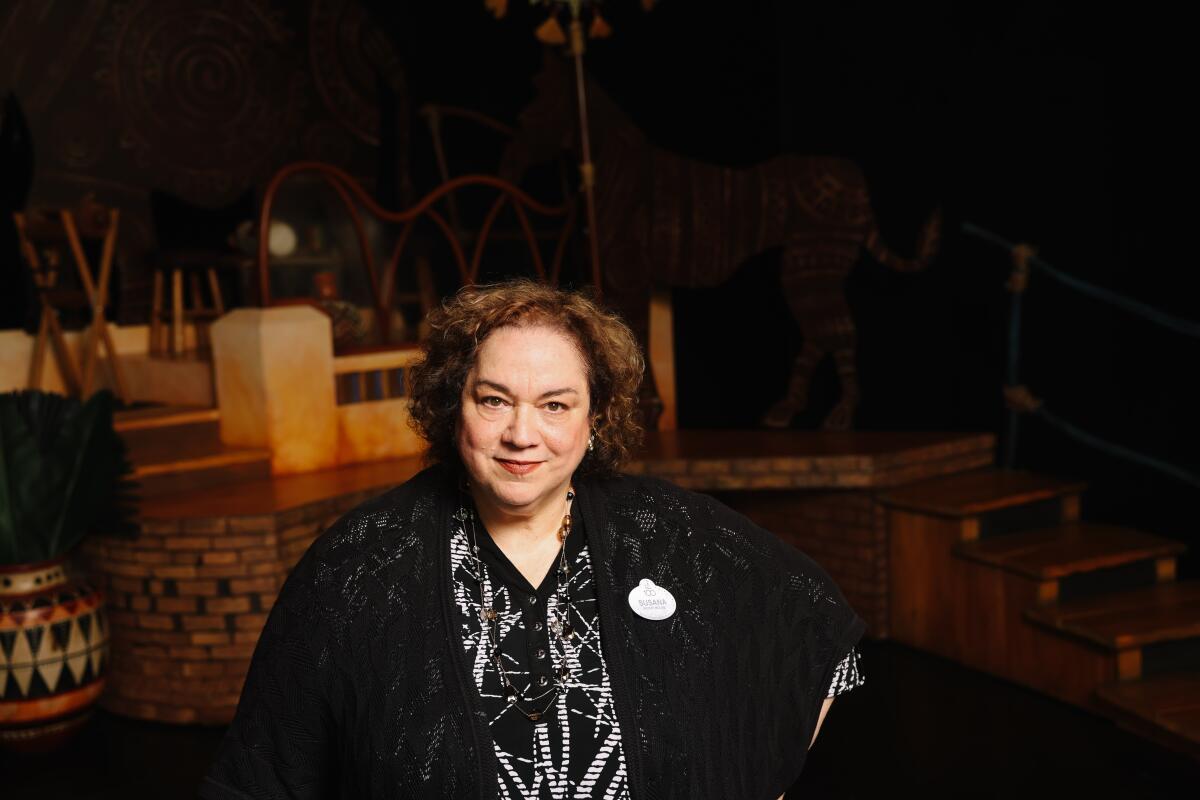
Tubert, born in Buenos Aires, moved to the United States with her family in 1977, landing in New York in the early ’80s when she was in her early 20s. Tubert initially wanted to act, and a stint at London’s Royal Academy of Dramatic Art was interrupted when her mother was diagnosed with cancer and Tubert had to return to America. She gradually discovered, however, that she felt more comfortable behind the curtain. Early on, she created plays and musicals for children’s theater, including one, she says, that was a musical about ecology and the quest to save the planet.
Such early experiences have served her well at Disney. “Tale of the Lion King,” which currently runs in Fantasyland, was initially envisioned as a tie-in for the 2019 Jon Favreau-directed remake, which emphasized realism in its portrayal of the animals.
Tubert found the best way to be honest with the show and to capture a sense of authenticity was to be realistic about its setting — inside a theme park — and the limitations that created, lessons she learned in her 20s with children’s theater. “I was less inclined toward naturalism and more into using the lie of theater to tell the truth of the story,” she says. “In ‘Tale of the Lion King,’ we embrace the lie of theater. You see actors move the scenery, changing costumes and they take off the mane and hold it. That means the character just died. I love that kind of theater. It’s painterly.”
By moving away from puppetry or a character-centered show, “Tale of the Lion King” is more readily able to lean into African dance, art and costume design. “The roots, the source, the cultural inspiration for the film is Africa — parts of Africa,” Tubert says.
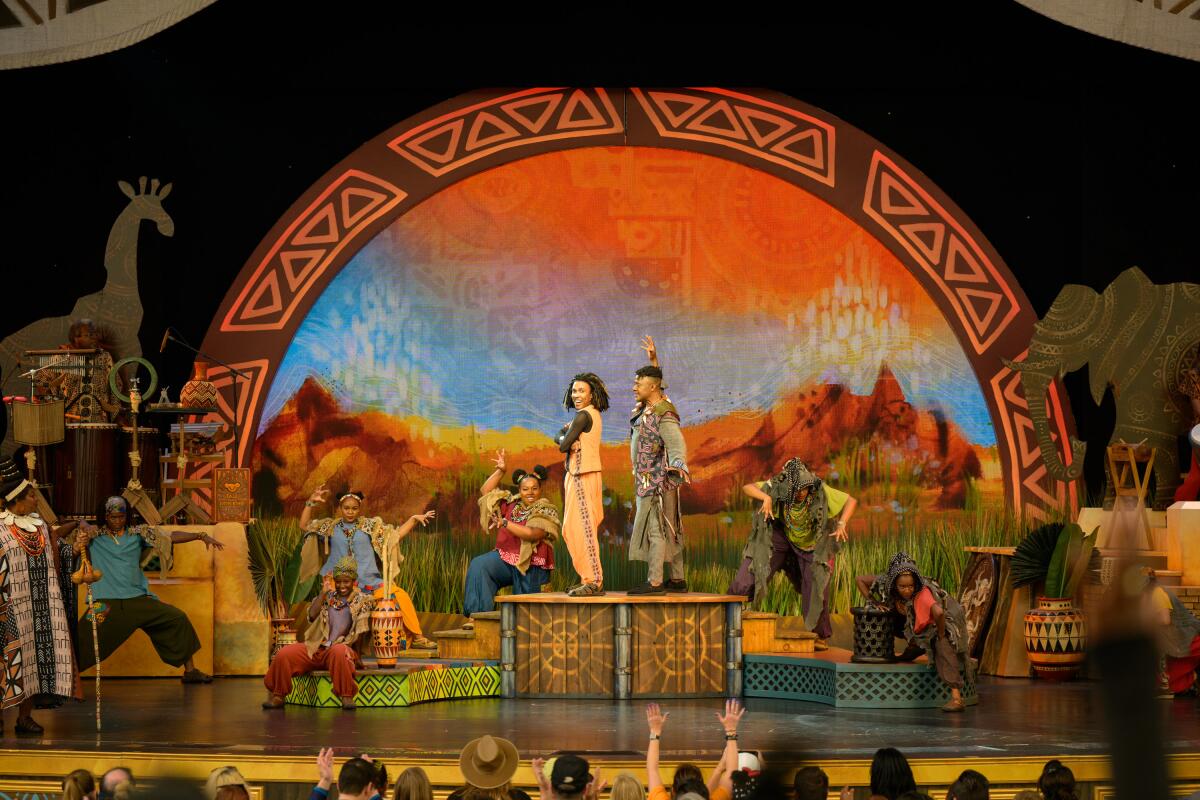
The show is treated as if it’s something that has been passed down through generations. “To me, it was a biblical thing, like ancestral,” Tubert says. “I wanted them to feel like they had an ancestry. It’s very easy for me to live in the magical realism space. It could be now. It could be thousands of years ago. I think that has to deal with emigrating. When you leave something behind, you evolve this idea of time and space and it’s different.”
Tubert has done a lot of leaving behind. For a significant period of her life, her career was on a vastly different track.
The recipient of a Theatre Communications Group/National Endowment for the Arts Directing fellowship in 1992, Tubert soon found herself assisting directors such as Prince and Peter Sellars. Her directing prowess eventually landed her that dream Broadway gig. But it wasn’t meant to be. Tubert became the first of four credited directors on Paul Simon’s “The Capeman.” She isn’t eager to to revisit the period but offered her thoughts on the short-lived, poorly received production.
“Successful musicals build to moments of great emotionality that can only be expressed in song,” Tubert says. “But the ill-fated ‘Capeman’ strung together musicalized narrations that described entire scenes. In the theater — great theater — the arc of a story should be shown, not told.”
It’s clear, however, she’s rejuvenated with her role at Disney, even though she was initially skeptical she could transition from the East Coast theater scene to the corporate home of America’s myths and fairy tales. Plotting her post-TeatroStageFest steps one night, Tubert chanced upon the job listing for Disneyland and reached out to friend Shelby Jiggetts-Tivony, now a vice president with Disney Parks Live Entertainment. Jiggetts-Tivony herself made the jump, having previously worked at Lincoln Center and the New York Shakespeare Festival (now called Shakespeare in the Park). She gave Tubert an impassioned speech about the power of theme parks.
“She made a comment like, ‘You and I have been wanting to bring theater to the masses for our entire careers, and there’s no more loyal audience than the Disney audience. Here are the reasons why I think this would be good for you and why I think you would be good for Disney.’ That persuaded me. I knew from a creative point of view I could do this job. I just didn’t know if I could fit into a corporate setting. But I felt like I was a little guppy taken from a small aquarium and put into a big tank. It was a big change, but I still went from water to water.”
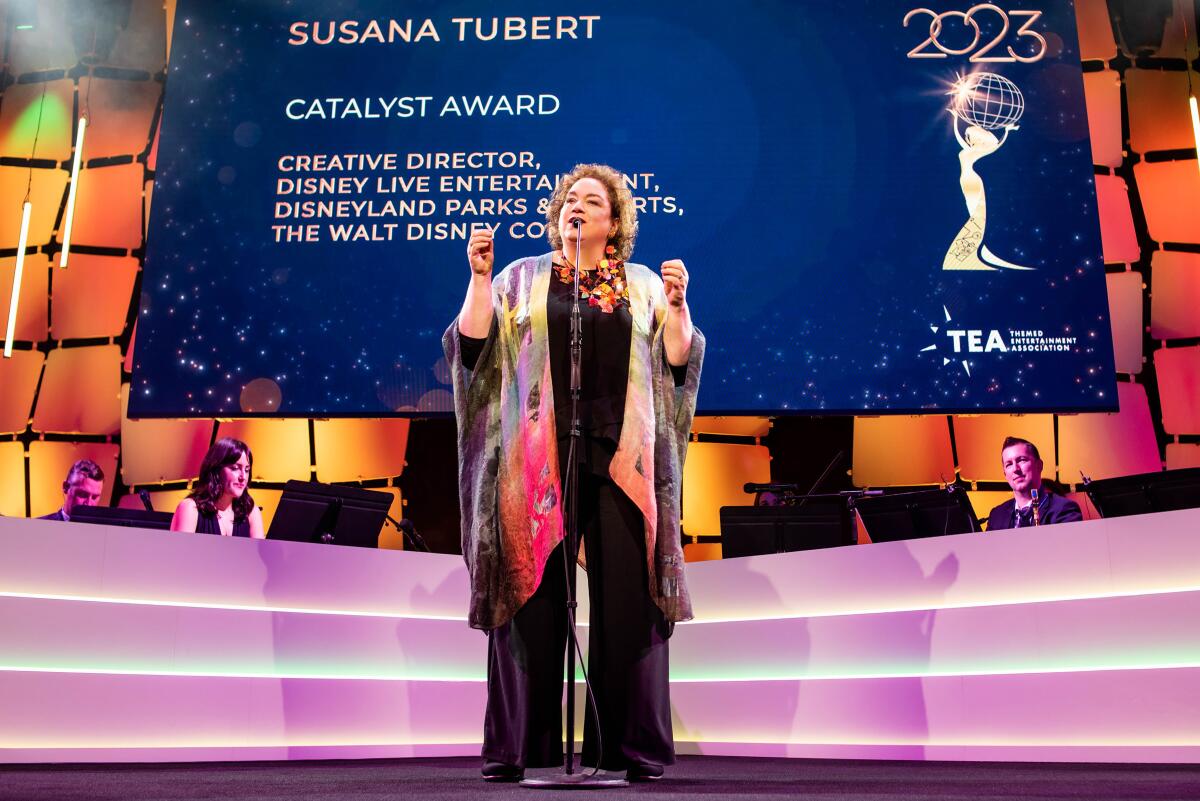
Asked specifically how Jiggetts-Tivony persuaded her, Tubert says her peer leaned heavily on Tubert’s background with inclusive storytelling. “I had been traveling to Spain and Colombia and Mexico and Brazil, and had produced two tours through South America,” Tubert says of her work with TeatroStageFest. “So I had been opening my head to all these amazing artists who were not U.S.-based, and I think she was excited about that possibility because this is a global company. Even though I was working in a theme park, there was an alignment from a holistic point of view.”
Tubert is part of the Walt Disney Co.’s Creative Inclusion Council and speaks of collaborating on 2021’s makeover of the Jungle Cruise as one of her career highlights. And while she’s hesitant to be known primarily for her diversity and inclusion efforts, it’s clear it’s a passion. When she speaks of collaborating on an event such as Disney California Adventure’s Halloween party, the Oogie Boogie Bash, she singles out characters from recent Disney and Pixar efforts that allowed the park to expand its representation.
“You can still take a thin brush and color across it by including Ernesto de la Cruz from ‘Coco’ and Bruno from ‘Encanto,’” Tubert said in a panel as part of receiving the Themed Entertainment Assn. honor. “There are ways for us to continue to embrace an inclusive narrative.”
This summer will be an important one for theater at the Disneyland Resort. Although Tubert isn’t directing the project, the highly anticipated Captain America-themed “Rogers: The Musical” will debut June 30 at California Adventure with her input. The Marvel production had its roots on Disney+ series “Hawkeye.” “I recently attended a workshop of ‘Rogers: The Musical’ and watched a run-through of the show in progress, after which I was invited to participate in a note session,” Tubert says. “I had the opportunity to share creative feedback with the show’s creative director, stage director, who is a member of my [Disney Live Entertainment] team, and other creative partners working on the production.”
She’s come to view theme parks as vital spaces, and almost compares Disneyland to ritualistic endeavors such as going to church. She stops short of that, but what Tubert is getting at holds sway for Disneyland devotees, as few places are as tied up in family history, nostalgia and modern pop culture. Storytelling, after all, is a way to make sense of the world, and Disneyland provides the opportunity to reconnect with familiar tales as a sort of rite of passage for each generation. And to do so, of course, in a public space with others.
“Civilization is trending in a direction of isolation,” Tubert says. “Theme parks are important because they can create an even playing field and a community, where it doesn’t matter where you come from and what your background is. We’re all in the same playground playing by the same rules. But it goes deeper. There’s a graciousness people tap into when they come here. ... When you walk into a theme park you feel like you are a part of a community. You smile together, you laugh together and you’re exhausted together. There’s an interesting breaking of walls that is here in this space.”
That breaking of walls that Tubert speaks of allows Disneyland, perhaps, to be one of our region’s grandest stages. When there’s no distance between the stage and the house, cast and guest, and make-believe and reality, we all become actors.
The new Jungle Cruise shows Disney wants to be in the cultural conversation rather than an artifact or, worse, a representation of the ‘good ole days.’
Ranking the rides and attractions at Disneyland and California Adventure from best to worst is hard — but not impossible. Here is the ultimate Disneyland ride ranking.
More to Read
The biggest entertainment stories
Get our big stories about Hollywood, film, television, music, arts, culture and more right in your inbox as soon as they publish.
You may occasionally receive promotional content from the Los Angeles Times.
